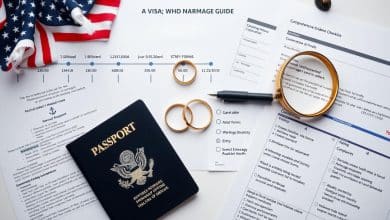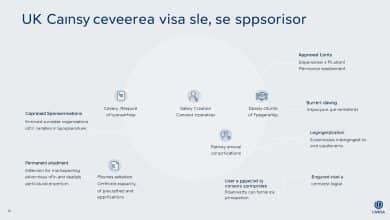Unlocking Opportunities in Australia: Visa Sponsorship and Marriage Visas Explained
Australia’s immigration system offers a gateway for skilled professionals, students, and families seeking new opportunities.
For Nigerian applicants, understanding the pathways of sponsorship and marriage visas is essential. These routes provide access to work rights, quality education, and family reunification.
Employer-sponsored visas are a popular choice for those aiming for permanent residency. They allow individuals to work and settle in the country while contributing to its economy. Marriage visas, on the other hand, enable families to stay together and build a future in a vibrant and diverse society.
Navigating the immigration process can be complex, but with the right guidance, it becomes manageable. This article provides structured insights to help applicants make informed decisions and achieve their goals.
Introduction to Visa In Australia
The process of entering this country begins with understanding its immigration rules. All noncitizens must obtain proper authorization before arrival. The legal framework, governed by the Migration Act 1958 and overseen by the Department of Home Affairs, ensures a structured and secure system.
For Nigerian nationals, meeting mandatory requirements is essential. These include providing accurate documentation and adhering to specific entry conditions. Clean criminal records and health compliance are critical factors that influence approval.
Electronic travel authorizations (eVisitor/ETA) are available for over 70 nationalities, offering short-term stays. These differ from long-term visas, which cater to extended periods for work, study, or family reunification. Applicants must choose the option that aligns with their purpose of visit.
Overstaying a visa can lead to severe consequences, including fines, deportation, or entry bans. It is vital to respect the terms of the authorization to avoid legal complications. Proper planning and adherence to rules ensure a smooth experience in this country.
Types of Visas Available in Australia
Exploring the diverse visa options can open doors to new opportunities. Whether you’re a student, a skilled worker, or looking to reunite with family, there’s a pathway tailored to your needs. Understanding these categories is essential for making informed decisions.
Student Visas
For those pursuing education, the Student Visa (subclass 500) is a popular choice. It requires a Confirmation of Enrolment (CoE), Overseas Student Health Cover (OSHC), and proof of funds amounting to $29,710. This visa allows students to stay for up to five years, depending on their course duration.
Work Visas
Skilled professionals can apply for the Temporary Skill Shortage (TSS) visa. This option aligns with the Short-Term Skilled Occupation List (STSOL) or Medium and Long-Term Strategic Skills List (MLTSSL). It’s ideal for those addressing labor shortages in specific industries.
Family and Partner Visas
Family reunification is made possible through Partner Visa pathways, which include provisional and permanent options. Regional visas often have shorter processing times compared to metropolitan ones. For parents, contributory options like subclass 143 offer faster processing than the non-contributory subclass 103, which can take over 20 years.
Each visa type has unique requirements and benefits. Choosing the right one depends on your goals and circumstances. Proper planning ensures a smoother application process and a successful journey ahead.
Understanding Visa Sponsorship
Securing a visa sponsorship can be a game-changer for skilled professionals aiming to work abroad. This process involves an employer taking responsibility for an applicant’s legal work status. For the Temporary Skill Shortage (TSS) visa, companies must first obtain Standard Business Sponsorship. They also need to prove they cannot find suitable local candidates for the role.
Employers have specific obligations in this process. They must meet training benchmarks and follow nomination procedures. Financial guarantees are often required to ensure sponsored employees are supported. These steps help maintain the integrity of the sponsorship system.
One of the key benefits of visa sponsorship is the transition from temporary to permanent residency. Many pathways allow sponsored workers to settle long-term. This is especially valuable for those looking to build a future in a new country.
Sector-specific opportunities are abundant in fields like healthcare, engineering, and IT. These industries often face skill shortages, making sponsorship more accessible. However, applicants must be aware of common pitfalls, such as incomplete documentation or mismatched qualifications.
Proper preparation and understanding of the process can make visa sponsorship a smooth and rewarding experience. With the right guidance, skilled professionals can unlock new opportunities and achieve their career goals.
Temporary Skilled Shortage Visa (Subclass 482)
The Temporary Skilled Shortage Visa (Subclass 482) is a key pathway for skilled workers to gain employment abroad. It allows professionals to fill critical roles in industries facing labor shortages. This visa is divided into two streams: Short-term and Medium-term, each catering to specific needs and goals.
Short-term Stream
The Short-term Stream is designed for occupations listed on the Short-Term Skilled Occupation List (STSOL). It offers a validity of up to two years, with the option to renew once. However, this stream does not provide a direct pathway to permanent residency.
Employers must meet specific requirements, including labor market testing to prove they cannot find suitable local candidates. Additionally, salary thresholds must align with the market rate to ensure fair compensation for workers.
Medium-term Stream
The Medium-term Stream targets occupations on the Medium and Long-Term Strategic Skills List (MLTSSL). It provides a four-year validity and a clear pathway to permanent residency after three years. This stream is ideal for professionals seeking long-term stability in their new country.
For example, a Nigerian IT professional secured sponsorship under the MLTSSL, enabling them to transition to permanent residency and build a successful career abroad.
“The Medium-term Stream offers not just a job but a future. It’s a chance to settle and grow in a new environment.”
Understanding the differences between STSOL and MLTSSL is crucial for applicants. Proper preparation, including verifying salary thresholds and ensuring compliance with labor market testing, can make the application process smoother and more successful.
Employer Nomination Scheme (Subclass 186)
The Employer Nomination Scheme (Subclass 186) is a pathway to permanent residency for skilled workers. It allows employers to sponsor qualified professionals to fill critical roles in their organizations. This scheme is divided into three streams: Temporary Residence Transition, Direct Entry, and Agreement. Each stream caters to different circumstances and eligibility criteria.
Temporary Residence Transition Stream
This stream is ideal for individuals who have already worked with their sponsor for at least two years. It provides a straightforward route to permanent residency for those on temporary visas. Applicants must meet specific requirements, including English proficiency benchmarks, such as an IELTS score of 6.0 or higher. Priority processing is available for occupations listed on the critical skills list.
Direct Entry Stream
The Direct Entry stream is designed for skilled workers who are not currently employed by their sponsor. Applicants must undergo a skills assessment to prove their qualifications. This stream is particularly beneficial for those with specialized expertise in high-demand industries. Regional migration agreements in areas like Western Australia and the Northern Territory offer additional opportunities for applicants.
Agreement Stream
The Agreement stream caters to individuals sponsored under labor agreements between the government and employers. It includes age limit exceptions for regional agreements, making it accessible to a broader range of applicants. This stream is tailored to meet specific industry needs and often involves priority processing for critical skill occupations.
Each stream offers unique benefits and requirements. Nigerian applicants should carefully evaluate their circumstances to choose the most suitable pathway. Proper preparation and adherence to guidelines can make the process smoother and more successful.
Skilled Migration Visas
Skilled migration offers a direct route for professionals to build a future abroad. These pathways are designed for individuals with specialized skills and qualifications. They provide opportunities to work, settle, and contribute to the economy of a new country.
Skilled Independent Visa (Subclass 189)
The Skilled Independent Visa (Subclass 189) is a points-based option for highly skilled workers. Applicants must score at least 65 points based on factors like age, qualifications, and English proficiency. Occupations must be listed on the Medium and Long-Term Strategic Skills List (MLTSSL).
For example, a Lagos engineer achieved this visa by excelling in English tests, earning extra points. Regional study bonuses can also boost scores, making this pathway accessible to many professionals.
Skilled Nominated Visa (Subclass 190)
The Skilled Nominated Visa (Subclass 190) requires state or territory nomination. This adds an extra layer of support to the application process. States often prioritize occupations that align with their economic needs.
Strategies for securing nomination include researching state-specific requirements and tailoring applications accordingly. This visa offers a clear pathway to permanent residency, making it a popular choice.
Skilled Work Regional Visa (Subclass 491)
The Skilled Work Regional Visa (Subclass 491) targets professionals willing to live and work in regional areas. It offers priority processing and access to expanded occupation lists. This makes it an attractive option for those seeking faster approval.
Regional visas also provide opportunities to contribute to local communities while building a stable future. Applicants must meet specific criteria, including state nomination and skill requirements.
Each skilled migration pathway has unique benefits and requirements. Understanding these options helps professionals choose the best route for their goals. Proper preparation ensures a smooth application process and a successful journey ahead.
Australian Partner Visas
For couples looking to build a life together, understanding the pathways for partner visas is essential. These visas allow family members to reunite and create a shared future. The process involves a thorough assessment of the relationship across financial, household, and social aspects.
The application is a two-stage process. First, applicants receive a provisional visa (subclass 309 or 820). After meeting specific criteria, they can transition to a permanent visa (subclass 100 or 801). This ensures that the relationship is genuine and long-lasting.
Temporary Partner Visa
The provisional stage is crucial for establishing the relationship’s authenticity. Applicants must provide proof of their commitment, such as joint leases, communication records, and statutory declarations. Financial requirements include evidence of shared expenses, typically amounting to $7,000 or more.
“The provisional visa is a stepping stone to permanent residency, offering couples the chance to build their lives together.”
Permanent Partner Visa
Once the provisional period is complete, applicants can apply for permanent residency. This stage requires continued proof of a genuine relationship. Onshore and offshore applications have slight differences, so it’s important to choose the right pathway based on location.
Australian law recognizes LGBTQ+ partnerships, ensuring inclusivity in the visa process. This makes it easier for diverse families to reunite and thrive in a supportive environment.
- Documentation: Joint leases, communication records, statutory declarations.
- Financial Proof: $7,000+ evidence of shared expenses.
- Recognition: LGBTQ+ partnerships are fully supported.
Understanding the partner visa process helps couples navigate the journey with confidence. Proper preparation ensures a smoother application and a brighter future together.
Prospective Marriage Visa (Subclass 300)
The Prospective Marriage Visa (Subclass 300) is designed for couples planning to marry and start a life together. This temporary visa allows engaged partners to reunite and prepare for their wedding. It is valid for nine months, during which the couple must marry and apply for a partner visa before the expiry date.
To be eligible, applicants must demonstrate a genuine intention to marry within the nine-month period. Evidence such as wedding deposits, venue bookings, and invitation copies is required. These documents help establish the authenticity of the relationship and the couple’s commitment to their future together.
During the provisional period, visa holders enjoy work rights and access to Medicare. This allows them to settle in and contribute to their new environment while planning their wedding. However, if the conversion to a partner visa is refused, applicants can appeal the decision through the appropriate channels.
“This visa is a bridge for couples to reunite and build their lives together before officially tying the knot.”
Cultural considerations are also important, especially for Nigerian applicants. Traditional engagement ceremonies, such as the Introduction or Knocking on the Door, can be included as part of the evidence. These practices highlight the couple’s commitment and align with cultural norms.
- Eligibility: Genuine intention to marry within nine months.
- Evidence: Wedding deposits, venue bookings, invitation copies.
- Benefits: Work rights and Medicare access.
- Appeal: Conversion refusal rates and appeal processes.
- Culture: Nigerian engagement ceremonies as supporting evidence.
Understanding the requirements and preparing thoroughly can make the application process smoother. This visa offers a unique opportunity for couples to reunite and plan their future together in a supportive environment.
New Zealand Citizen Family Relationship Visa (Subclass 461)
The New Zealand Citizen Family Relationship Visa (Subclass 461) provides a unique opportunity for families to stay connected. This 5-year temporary visa allows family members of New Zealand citizens to live and work abroad. It is renewable onshore, offering flexibility for long-term plans.
Eligibility for this visa extends to de facto relationships, ensuring inclusivity for diverse family structures. While the visa itself is non-extendable, holders can apply for multiple renewals. This makes it a practical option for those seeking continuity in their living arrangements.
Special exceptions exist for children born in Australia. These cases often have streamlined pathways, simplifying the process for families. Tax implications are another consideration for 461 visa holders. Understanding these can help in financial planning and compliance.
Compared to the Trans-Tasman Travel Arrangements, the Subclass 461 visa offers distinct advantages. It provides a more structured and renewable solution for families. This makes it a preferred choice for those looking to maintain strong family ties while living abroad.
“The Subclass 461 visa ensures families can remain together while navigating life in a new country.”
Key features of this visa include:
- 5-year temporary duration with onshore renewal options.
- Eligibility through de facto relationships.
- Pathway exceptions for children born in Australia.
- Tax considerations for visa holders.
- Comparison with Trans-Tasman Travel Arrangements.
Understanding the Subclass 461 visa helps families make informed decisions. It ensures they can stay connected while building a future abroad.
Australian Parent Visas
Reuniting with family members abroad is a priority for many Nigerian applicants. Parent visas provide a pathway for elderly parents to join their children and build a life together. These options require careful planning, especially when considering financial capacity and long-term support.
Contributory Parent Visa (Subclass 143)
The Contributory Parent Visa (Subclass 143) is a popular choice for those willing to make a financial contribution. Applicants must pay $43,600 AUD, which helps expedite processing times. This option is ideal for families who can meet the financial requirements and want to avoid long waiting periods.
Key features include the Assurance of Support (AoS) bond, which ensures sponsors can provide financial support. Healthcare costs for elderly parents are another consideration, as they may require ongoing medical attention. This visa offers a balance between cost and convenience, making it a preferred option for many.
Parent Visa (Subclass 103)
The Parent Visa (Subclass 103) is a non-contributory option with a significantly longer processing time. Current estimates suggest a wait of up to 30 years. This pathway is suitable for those who cannot meet the financial requirements of the contributory visa but are willing to wait.
Applicants must pass the balance-of-family test, which requires at least 50% of their children to be permanent residents or citizens. This ensures that the family has a strong connection to the country. While the wait is long, this visa remains a viable option for many families.
“Choosing between contributory and non-contributory options depends on your financial capacity and urgency.”
Recent policy changes have impacted Nigerian applicants, particularly in terms of processing times and eligibility criteria. It’s essential to stay updated on these changes to make informed decisions. Proper planning and understanding of the requirements can make the process smoother and more successful.
- Balance-of-family test: At least 50% of children must be permanent residents or citizens.
- Assurance of Support (AoS) bond: Ensures sponsors can provide financial support.
- Healthcare costs: Consider ongoing medical needs for elderly parents.
- Contributory vs. non-contributory: Weigh financial capacity against processing times.
- Recent policy changes: Stay informed about updates affecting Nigerian applicants.
Understanding the parent visa options helps families make the best choice for their circumstances. Whether opting for the contributory or non-contributory pathway, proper preparation ensures a smoother journey toward reuniting with loved ones.
Student Visa Application Process
Navigating the student visa application process requires careful preparation and attention to detail. For Nigerian applicants, understanding the steps and requirements is crucial to ensure a smooth journey. This section breaks down the key components of the process, from securing a letter of offer to meeting health and character requirements.
Letter of Offer
The first step in the student visa application is obtaining a letter of offer from an educational institution. This document confirms your acceptance into a course of study. Letters can be conditional or unconditional, depending on whether additional requirements, such as English proficiency, need to be met.
Confirmation of Enrolment (CoE)
Once you accept the offer, the institution issues a Confirmation of Enrolment (CoE). This is a critical document for your visa application. CoE issuance timelines vary across universities, so it’s important to plan ahead and avoid delays.
Proof of English Proficiency
Most institutions require proof of English proficiency through approved tests like IELTS, TOEFL, or PTE. Each test has specific score thresholds that must be met. For Nigerian applicants, preparing early for these tests can make a significant difference.
Genuine Student Requirement
Applicants must demonstrate their genuine intention to study through a Genuine Temporary Entrant (GTE) statement. This document outlines your study goals, ties to your home country, and plans after completing your course. Writing a compelling GTE statement is essential for approval.
Financial Capacity Requirement
Proof of financial capacity is mandatory for the student visa application. Applicants must show they have at least $29,710 AUD to cover tuition and living expenses. This ensures you can support yourself during your studies.
Overseas Student Health Cover (OSHC)
OSHC is a requirement for all international students. It provides access to healthcare services during your stay. Comparing providers like Allianz and Bupa can help you choose the best coverage for your needs.
Health and Character Requirements
Applicants must meet health and character standards to qualify for a student visa. This includes undergoing medical examinations and providing police clearance certificates. Ensuring all documents are up-to-date is vital for a successful application.
“Proper preparation and attention to detail are the keys to a successful student visa application.”
- Letter of Offer: Conditional vs. unconditional acceptance.
- CoE: Issuance timelines vary by institution.
- English Proficiency: IELTS, TOEFL, or PTE scores required.
- GTE Statement: Write a compelling narrative.
- Financial Proof: Show $29,710 AUD in funds.
- OSHC: Compare Allianz and Bupa coverage.
- Health and Character: Medical exams and police checks.
Applying for a Visa Using ImmiAccount
ImmiAccount simplifies the visa application process for Nigerian applicants. This online platform allows users to manage their applications efficiently, whether they choose to apply independently or through a registered agent. It’s a convenient service that streamlines the entire process.
To get started, users need to register on ImmiAccount. The step-by-step guide includes creating an account, verifying email addresses, and setting up a secure password. Once registered, applicants can upload required documents in PDF format, ensuring they meet size limits and clarity standards.
Payment options are tailored for Nigerian applicants, with secure gateways available for processing fees. Tracking the application status is straightforward, with real-time updates on processing times. This feature helps applicants stay informed throughout the process.
To avoid red flags, consistency across all forms is crucial. Inconsistent information can delay or even jeopardize the application. Registered agents can also access the portal, providing additional support for those who prefer professional assistance.
“ImmiAccount is a game-changer for applicants, offering transparency and ease of use.”
Key steps to remember:
- Register and verify your ImmiAccount.
- Upload documents in PDF format, adhering to size limits.
- Use secure payment gateways for fees.
- Track your application status regularly.
- Ensure consistency across all forms to avoid delays.
Travel Requirements and Preparation
Traveling abroad requires careful planning, especially when it comes to health and insurance coverage. For Nigerian applicants, understanding these requirements ensures a smooth journey and avoids last-minute issues.
Overseas Student Health Cover (OSHC) is mandatory for international students. It provides access to medical care but does not include dental or optical services. Additionally, COVID-19 declarations are required to comply with current health regulations.
Biometric data collection is a crucial step in the application process. Applicants must visit VFS Global Nigeria centers to complete this requirement. It’s essential to schedule an appointment in advance to avoid delays.
Customs restrictions are another important consideration. Prohibited items include certain food and plant products. Familiarizing yourself with these rules helps prevent issues at the border.
Before departure, ensure you have certified copies of all necessary documents. Orientation materials can also help you prepare for the cultural and logistical aspects of your journey.
For those with connecting flights, airport transit visa requirements must be checked. Each country has its own rules, so verify these details beforehand.
Cultural adaptation resources are available to help Nigerian arrivals settle in. These include guides on local customs, language tips, and community support networks.
- OSHC: Covers medical care but excludes dental and optical services.
- Biometric Collection: Visit VFS Global Nigeria centers for data collection.
- Customs Restrictions: Avoid prohibited food and plant items.
- Pre-Departure Checklist: Certified document copies and orientation materials.
- Airport Transit Visa: Check requirements for connecting flights.
- Cultural Adaptation: Utilize resources for smoother integration.
Common Mistakes to Avoid in Visa Applications
Avoiding common errors in the visa application process can significantly improve approval chances. Many Nigerian applicants face challenges due to overlooked details, leading to a 37% refusal rate for student visas, often caused by Genuine Temporary Entrant (GTE) failures.
One frequent mistake is incomplete financial documentation. Applicants must provide six-month bank statements to prove they can cover tuition and living expenses. Missing or unclear records can result in immediate rejection.
Another issue is mismatched course selection. Choosing a program unrelated to academic history raises red flags. It’s essential to align studies with previous qualifications to demonstrate genuine intent.
Overlooking police certificates for long stays is another common error. These documents are crucial for proving good character. Applicants must ensure all required checks are completed and submitted on time.
“Last-minute submissions often lead to avoidable mistakes. Starting early ensures all documents are accurate and complete.”
Using unregistered migration agents can also cause problems. Registered professionals provide reliable guidance, while unregistered ones may offer incorrect advice, jeopardizing the application.
By addressing these mistakes, applicants can enhance their chances of success. Proper preparation and attention to detail are key to a smooth visa application process.
Conclusion
Navigating the immigration process requires careful planning and a clear understanding of available pathways. From employer-sponsored options to family reunification routes, each pathway offers unique opportunities for skilled professionals and families alike. Early preparation and professional guidance can significantly enhance the chances of success.
Emerging trends, such as increased skilled migration quotas for 2024, highlight the growing demand for qualified individuals. Staying informed about these changes ensures applicants can align their goals with current opportunities.
For Nigerian applicants, a final checklist includes verifying financial capacity, gathering necessary documents, and ensuring compliance with health and character requirements. These steps streamline the application process and reduce the risk of delays.
Ready to take the next step? Explore visa assessment services to receive tailored advice and support for your journey. With the right resources, building a brighter future becomes achievable.
For more information explore the official visa website mentioned in this article:
You will be redirected to another website
FAQ
What is the Temporary Skilled Shortage Visa (Subclass 482)?
The Temporary Skilled Shortage Visa (Subclass 482) allows employers to sponsor skilled workers for temporary roles in Australia. It has two streams: short-term and medium-term, depending on the occupation and duration of stay.
How does the Employer Nomination Scheme (Subclass 186) work?
The Employer Nomination Scheme (Subclass 186) is a permanent residency pathway for skilled workers. It includes three streams: Temporary Residence Transition, Direct Entry, and Agreement Stream, each with specific eligibility criteria.
What are the key requirements for a Student Visa?
Applicants must provide a Letter of Offer, Confirmation of Enrolment (CoE), proof of English proficiency, financial capacity, and Overseas Student Health Cover (OSHC). They must also meet health and character requirements.
What is the difference between a Temporary and Permanent Partner Visa?
A Temporary Partner Visa allows applicants to live in Australia while their permanent application is processed. The Permanent Partner Visa grants long-term residency once the relationship is proven genuine and ongoing.
What is the Prospective Marriage Visa (Subclass 300)?
The Prospective Marriage Visa (Subclass 300) is for individuals planning to marry an Australian citizen or permanent resident. It allows a nine-month stay to arrange and finalize the marriage.
Can New Zealand citizens apply for a Family Relationship Visa?
Yes, New Zealand citizens can apply for the New Zealand Citizen Family Relationship Visa (Subclass 461), which allows eligible family members to live and work in Australia temporarily.
What are the options for Australian Parent Visas?
Parents can apply for the Contributory Parent Visa (Subclass 143) or the Parent Visa (Subclass 103). The Contributory option is faster but requires higher fees, while the non-contributory option has a longer processing time.
How do I apply for a visa using ImmiAccount?
ImmiAccount is an online portal where applicants can submit and manage their visa applications. It requires creating an account, uploading necessary documents, and paying the associated fees.
What are common mistakes to avoid in visa applications?
Common mistakes include incomplete forms, insufficient supporting documents, incorrect information, and failing to meet health or character requirements. Double-checking all details is essential.
What is Overseas Student Health Cover (OSHC)?
OSHC is mandatory health insurance for international students in Australia. It covers medical and hospital expenses, ensuring students have access to healthcare during their stay.
Published on: 21 de May de 2025

Abiade Martin
Abiade Martin, author of WallStreetBusiness.blog, is a mathematics graduate with a specialization in financial markets. Known for his love of pets and his passion for sharing knowledge, Abiade created the site to provide valuable insights into the complexities of the financial world. His approachable style and dedication to helping others make informed financial decisions make his work accessible to all, whether they're new to finance or seasoned investors.






